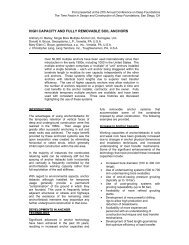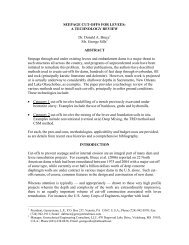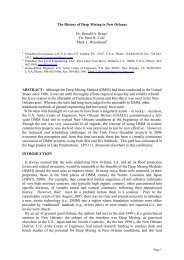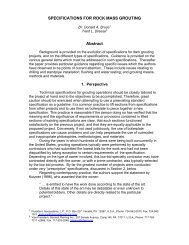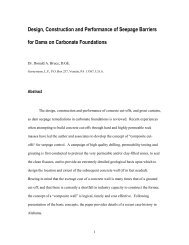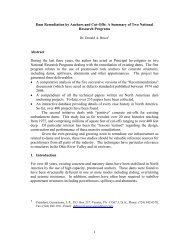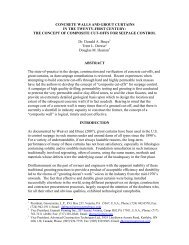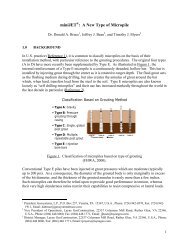High Capacity Grouted Micropiles - Geosystems, LP
High Capacity Grouted Micropiles - Geosystems, LP
High Capacity Grouted Micropiles - Geosystems, LP
You also want an ePaper? Increase the reach of your titles
YUMPU automatically turns print PDFs into web optimized ePapers that Google loves.
<strong>Micropiles</strong> are mainly used in the U.S. for structural support, but<br />
are becoming increasingly popular for in situ reinforcement<br />
(Figure 1). This paper reviews only the former application<br />
wherein groups of Case 1 micropiles (Section 2 below) are employed<br />
to accept load directly, as small diameter substitutes for<br />
other pile types. <strong>Micropiles</strong> are used to solve problems where<br />
logistical and/or geotechnical factors conspire to rule out other<br />
types of support.<br />
Physical constraints include<br />
• Situations with low overhead clearance;<br />
• Tight working conditions inside existing structures;<br />
• Sites with limited plan area access, e.g., in hallways or<br />
against a face of walls; and<br />
• Situations where it is necessary to attach small piling elements<br />
directly through the existing foundation elements.<br />
Geotechnical constraints include<br />
• Karstic limestone geology (with voids or soil-filled solution<br />
cavities);<br />
• Bouldery ground or glacial till;<br />
• Variable and/or random fill;<br />
• Underlying existing foundations or man-made obstructions;<br />
• Rock formations with variable weathering (e.g., hard zones<br />
overlying softer layers); and<br />
• Soils under a high water table.<br />
<strong>Micropiles</strong> offer the following advantages<br />
• Small and powerful equipment is used to negotiate tight<br />
physical spaces;<br />
• Drilling is quiet, vibration free, and causes little or no loss of<br />
ground around each pile installation;<br />
• Drill spoil can be diverted from the hole location to provide a<br />
clean environment within operating facilities;<br />
• The drilling equipment can be used to install tie-down anchors<br />
that provide the primary uplift resistance for vertical<br />
pile load testing;<br />
• Larger casing pipes can be used in the upper portions of the<br />
piles to obtain significant lateral load resistance; and<br />
• Many variations of drilling, grouting, and structural configurations<br />
make for a fully customized and optimal solution.<br />
Various practitioners have proposed classifications based on diameter,<br />
some constructional process, or by the type of reinforcement.<br />
The FHWA team derived a new classification which<br />
is now being used nationwide and is based on two criteria:<br />
• The philosophy of system behavior, and<br />
• The method of grouting.<br />
The former criterion dictates the basis of the overall design<br />
concepts, and the latter is the principal determinant of<br />
grout/ground bond capacity.<br />
2.1 Classification Based on Philosophy of Behavior<br />
<strong>Micropiles</strong> are usually designed to transfer structural loads to<br />
more competent or stable strata. They therefore act as substitutes<br />
or alternatives for other conventional pile systems. For<br />
axially loaded piles, the pile/ground interaction is in the form of<br />
side shear and so is restricted to that zone of ground immediately<br />
surrounding the pile. For micropiles used as in situ reinforcements<br />
for slope stabilization, pile/ground interaction occurs only<br />
relatively close to the slide plane, although above this level, the<br />
pile group may also provide a certain degree of continuity to the<br />
pile/ground composite structure. In both cases, however, the pile<br />
(principally the reinforcement) resists directly the applied loads.<br />
This is equally true for cases when individual piles or groups of<br />
piles are used. In this context, a group is defined as a tight collection<br />
of piles, each of which is subjected to direct loading.<br />
Depending on prevailing codes relating to pile group design, individual<br />
pile design capacity may have to be reduced in conformity<br />
with conventional “reduction ratio” concepts. These concepts<br />
were typically developed for driven piles, and so this<br />
restriction is almost never enforced for micropiles, given their<br />
mode of construction which tends to improve, not damage, the<br />
soil mass between piles.<br />
When axially-loaded piles of this type are designed to transfer<br />
their load only within a remote founding stratum, pile head<br />
movements will occur during loading, in proportion to the length<br />
and composition of the pile shaft between structure and the<br />
founding stratum, and the load. Piles of this type can be preloaded<br />
(Bruce et al. 1990) to ensure that the overlying structure<br />
can be supported without further movements occurring. Equally,<br />
if suitably competent ground conditions exist all the way down<br />
from below the structure, then the pile can be fully bonded to the<br />
Review of<br />
Applications<br />
Structural<br />
Support<br />
In-Situ<br />
Reinforcement<br />
Foundation<br />
for New<br />
Structures<br />
Underpinning<br />
of Existing<br />
Foundations<br />
Seismic<br />
Retrofitting<br />
Embankment,<br />
Slope, and<br />
Landslide<br />
Stabilization<br />
Soil<br />
Strengthening<br />
and<br />
Protection<br />
Settlement<br />
Reduction<br />
Structural<br />
Stability<br />
Repair /<br />
Replacement<br />
of Existing<br />
Foundations<br />
Arresting /<br />
Prevention of<br />
Movement<br />
Upgrading of<br />
Foundation<br />
<strong>Capacity</strong><br />
Figure 1. Classification of micropile applications.<br />
2. CLASSIFICATION OF MICROPILES USED IN THE U.S.



